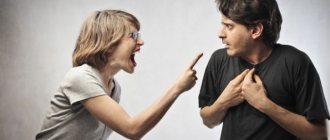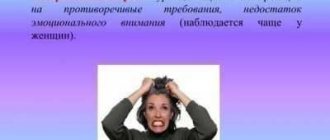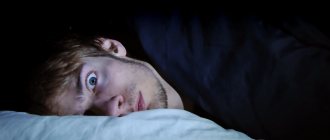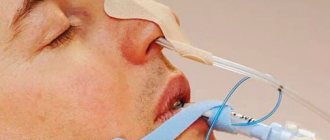Hysteria in men is a mental disorder from the group of neuroses, which is characterized by a temporary disturbance of consciousness, sensory and motor spheres, and a low level of self-control. People with this diagnosis are easily suggestible, dependent, infantile and prone to demonstrative behavior. Hysterical neuroses manifest themselves as a result of mental discomfort and the transfer of internal conflicts to somatic grounds. That is why, during moments of exacerbation, patients feel not only moral suffering, but also physical suffering, from phantom pain to temporary muscle paralysis, blindness or deafness. Male hysteria is a mental illness that seriously impairs the quality of life. Experienced medical psychotherapists will help you solve the problem anonymously, quickly and effectively.
Description of the disorder
The term “hysteria” first appeared in Ancient Greece, but at that time it was believed that the problem only affected the female sex, and its main cause lay in sexual dissatisfaction. Over time, symptoms of mental pathology were also noticed in men, so the disease no longer had a gender characteristic . Scientists have discovered that the etiology of the problem is associated with completely different factors.
The cause of the development of hysterical disorder in men can be a prolonged stay in a state of stress. But the trigger factor becomes a situation that traumatizes the psyche:
- breakup of a long-term relationship, divorce;
- excessive mental stress;
- unexpected dismissal, financial crisis;
- accidents, any global disasters and events;
- illness or death of a close friend, family member, etc.
In such situations, the cause of a hysterical attack may even be a banal refusal of the patient’s relatives to follow his wishes and demands.
A similar disorder develops in people with a certain type of character. Individuals who have been diagnosed are characterized by strong suggestibility, mild excitability and emotional lability. They often become victims of financial scams of all kinds of “healers and psychics” who have at least a little understanding of psychology. Often there is a history of mental pathologies of the schizoid spectrum.
Men with a similar disorder try to attract attention to themselves and evoke pity with fictitious diseases . But after some time, due to strong self-hypnosis and the reinforcement of already habitual reactions by the nervous system, they actually begin to feel very bad.
The main symptoms of hysteria in men
If at the initial stage of the disorder patients simply behave inappropriately and often throw tantrums with breaking dishes, scandals and strong resentment, then in the later stages this form of neurosis acquires more serious signs .
What is important is that the presence of certain symptoms cannot be explained by any organic pathologies. A person can contact specialists of various profiles to no avail, but doctors cannot find the reasons for poor health, and relief never comes.
A number of symptoms will help determine that we are talking about male hysteria, the main one of which can be called a hysterical attack.
Treatment
First aid for a hysterical attack:
- the patient cannot be restrained by force, this will only intensify the manifestation of symptoms;
- It is best to remove it from surrounding people;
- give ammonia a sniff;
- during a hysterical attack, it is necessary: not to leave the room in which the patient is, but at the same time not to pay attention to him.
If the cause of this condition is determined, and it lies in the pathology of the central nervous system, then in this case it is treated with medication.
Signs of a hysterical attack
It is very easy to notice such a situation. At the time of an unpleasant incident, the most unpleasant symptoms are felt:
- lack of oxygen;
- painful tingling in the heart area;
- simultaneous laughter and crying;
- lump in the throat;
- in some cases - falling to the ground, arching the body with support on the back of the head and heels;
- convulsive states, manifested by chaotic movements of the arms and legs.
At the same time, a person can behave very demonstratively - scratching his skin, tearing his clothes, breaking, throwing objects that come to hand. An important feature is that it does not cause serious harm to your health.
Also, during an exacerbation of hysteria in men, the following may be observed:
- temporary deafness in one ear;
- a radical change in the perception of colors;
- flashing “flies” before the eyes;
- imaginary blindness (the organs of vision function quite normally, but the patient seems to see nothing).
Often such seizures are confused with epileptic ones due to the similarity of symptoms. But they are still easy to differentiate, because, unlike epilepsy, with male hysteria:
- the patient is not injured and understands perfectly what is happening to him;
- there is no urinary or fecal incontinence;
- pupils react well to light;
- the patient does not bite his tongue, the color of the skin practically does not change.
In addition, such incidents always happen only when there are witnesses.
Symptoms
Many people confuse epileptic and hysterical seizures. But in fact, these are two completely different conditions that manifest themselves for different reasons. An epileptic seizure is characteristic of a disease such as epilepsy, while a hysterical seizure is more likely a consequence of mental disorders.
Signs of a hysterical attack:
- the patient falls (does this carefully so as not to harm himself);
- limbs move convulsively (which is why many people confuse a hysterical and convulsive attack);
- the patient does not lose consciousness;
- foam does not come out of the mouth;
- the patient never bites his tongue (as happens in the case of an epileptic seizure);
- the reaction of the pupils to light is preserved.
A hysterical attack usually lasts from several minutes to hours. The duration is directly related to how much attention the sick person will receive during this time.
Movement disorders
Hysterics may experience the following disorders:
- astasia and abasia (there is no ability to walk or stand independently, but the limbs function when lying down);
- hysterical paresis or complete paralysis of muscle tissue;
- tremor;
- tics;
- torticollis;
- hysterical contractures (impossibility of bending limbs).
Such disorders appear only in a state of wakefulness; during sleep, the symptoms disappear.
Speech problems
The patient may experience mutism (lack of speech), stuttering, or hysterical chanting (pronunciation of individual words, and sometimes phrases and entire sentences in syllables). Often he begins to speak in a whisper or his speech becomes inarticulate. At the same time, the man does not experience any discomfort; he finds other, convenient ways to communicate, for example, using facial expressions or notes.
Affective disorders
In most cases, in parallel with a demonstrative manner of behavior, there is an overly intense emotional experience. Despair, horror or rage can be traced in movements and facial expressions, all this is accompanied by theatrical poses, strong sobs and screams. Often this behavior becomes the cause of another seizure.
With male hysteria, other disorders occur:
- constipation;
- nausea;
- causeless sharp pain;
- dysuric disorders, etc.
The severity of the clinical picture can vary: from barely noticeable symptoms to very intense ones. Signs of neurosis can replace each other depending on the situation in which the patient finds himself. A common feature is a clear concentration on one’s well-being and drawing attention to one’s own person.
Hysterical neurosis
Unlike psychopathy, manifestations of hysteria appear most clearly with the participation of other people. It is characterized by demonstrativeness - an essential condition for the manifestation of hysterical neurosis. The patient's complaints and manifestations of the disease are not based on organic changes. All symptoms of mental pathology end as suddenly as they began.
The clinical picture of hysterical neurosis is characterized by diversity and polymorphism. Motor disturbances are observed: finger tremor, poor coordination, loss of voice (aphonia). Muscle tics (hyperkinesis) and cramps are often demonstrated. At the same time, all symptoms intensify during a medical examination by a pediatrician, therapist, neurologist and other specialists.
Hysterical aphonia is distinguished by a sonorous cough against the background of the absence of a voice. When stuttering occurs against the background of hysteria, the patient does not experience inconvenience or embarrassment. Paralysis during hysteria is never accompanied by tissue atrophy (a difference from ischemic stroke). The main difference between such paralysis is its localization: the patient indicates weakness or insubordination of the muscles on the arm to the elbow or on the leg to the knee, which is incompatible with an organic lesion of a neurological nature.
A severe form of the disease can manifest as partial (paresis) or complete paralysis of the limbs and tongue muscles. Movement disorders are not based on organic pathology; motor impairment is short-lived and depends on the patient’s peace of mind. The desire to attract maximum attention to oneself stimulates the patient to false fainting, demonstrative wringing of hands, shortness of breath and thrashing. However, if it is possible to switch the patient’s attention from his person to another object, motor disturbances will either greatly weaken or disappear altogether.
Sensory disturbances can manifest themselves as a decrease or absence of sensitivity (hypoesthesia, anesthesia), or its increase (hyperesthesia). In this case, the distribution of such signs is typical: patients limit the zone of numbness to the area of gloves, socks, vests, etc. Specific pain often occurs - causeless pain in any part of the body.
A frequent manifestation of a hysterical reaction is sudden deafness or blindness (one- or two-sided). Patients may exhibit distorted color perception and narrowing of visual fields, but this does not at all prevent them from adequately orienting themselves in space. Deafness is often combined with paresthesia/anesthesia of the auricle.
Vegetative manifestations are limited by the patient’s imagination. He may complain of pain in any internal organ, most often the gastrointestinal tract and heart. Sometimes patients refuse to eat due to a false spasm of the esophagus. Nausea, abdominal pain, retching, heart pain, difficulty breathing, palpitations, or heart palpitations have no basis; In most cases, there are no pathological changes in these organs that can cause such symptoms.
The patient may complain of burning and itching of the skin, showing the doctor scratches on the arms and legs as confirmation. Almost always, patients report dizziness and headache, explaining this by pathology in the brain. Sometimes patients imitate the symptoms of appendicitis and bronchial asthma.
A sharp deterioration in condition (seizure) during hysteria is very similar to the manifestation of epilepsy. Any situation that is psychologically difficult for the patient to perceive—a quarrel, unpleasant news, the refusal of others to fulfill the patient’s wishes—ends with a theatrical seizure. This may be preceded by dizziness, nausea and other signs of pseudo-deterioration.
The patient falls, bending into an arc. In this case, the patient will always fall “correctly”, trying to protect himself as much as possible from injury. Waving his arms and legs, hitting his head on the floor, violently expressing his emotions with tears or laughter, the patient portrays unbearable suffering. Unlike an epileptic, a hysteric does not lose consciousness; the reaction of the pupils is preserved. A loud shout, sprinkling cold water on the face or a slap in the face will quickly bring the patient to his senses. The patient’s complexion also gives away his complexion: during an epileptic seizure, the face is purple-bluish, and during hysteria, it is red or pale.
A hysterical attack, unlike an epileptic one, never occurs in a dream. The latter always happens in public. If the audience stops paying attention to the hysterical's convulsions or moves away, the seizure will quickly end. After an attack, the patient may exhibit amnesia, even to the point of not knowing his own first and last name. However, this manifestation is short-term; memory restoration occurs quite quickly, since it is inconvenient for the patient himself.
Hysteria is the “great simulator.” The patient speaks vividly about his complaints, excessively demonstrating their confirmation, but at the same time shows emotional indifference. One might think that the patient enjoys his many “illnesses”, while considering himself a complex person who requires close and comprehensive attention. If the patient learns about any manifestations of the disease that were previously absent, these symptoms are likely to appear.
Cost of services
| CONSULTATIONS OF SPECIALISTS | |
| Initial consultation with a psychiatrist (60 min.) | 6,000 rub. |
| Repeated consultation | 5,000 rub. |
| Consultation with a psychiatrist-narcologist (60 min.) | 5,000 rub. |
| Consultation with a psychologist | 3,500 rub. |
| Consultation with Gromova E.V. (50 minutes) | 12,000 rub. |
| PSYCHOTHERAPY | |
| Psychotherapy (session) | 7,000 rub. |
| Psychotherapy (5 sessions) | 30,000 rub. |
| Psychotherapy (10 sessions) | 60,000 rub. |
| Group psychotherapy (3-7 people) | 3,500 rub. |
| Psychotherapy session with E.V. Gromova (50 minutes) | 12,000 rub. |
| TREATMENT IN A HOSPITAL | |
| Ward for 4 persons | 10,000 rub./day |
| Ward for 3 persons | 13,000 rub./day |
| Ward 1 bed VIP | 23,000 rub./day |
| Individual post | 5,000 rub. |
| PETE | 15,000 rub./day |
This list does not contain all prices for services provided by our clinic. The full price list can be found on the “Prices” , or by calling: 8(969)060-93-93. Initial consultation is FREE!
Treatment of hysteria in men
Specialists at the Leto clinic use both medicinal methods and psychocorrection. The treatment plan will depend on the stage of the disease, the patient’s condition and his suggestibility:
- If necessary, a course of small doses of tranquilizers can be prescribed, sometimes in combination with antipsychotics.
- If the pathology is accompanied by sleep disorders, sleeping pills are prescribed.
- Good results are shown by psychotherapy sessions , in which the doctor identifies a traumatic factor, works through it together with the patient, and teaches how to cope and overcome various stressful situations.
- In some cases, psychiatrists use the method of hard-art therapy.
- To consolidate the achieved effect, physical therapy, sports or walking in the fresh air are often used.
It should be noted that in general the prognosis for hysterics is favorable. With adequate treatment and a lasting effect, long-term remission can be achieved. But some patients at risk will still have to be observed by specialists in the future to prevent relapses.
Tired of living in constant tension? To make an appointment, call us at 8(969)060-93-93 . We are waiting for you in!











